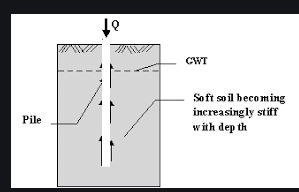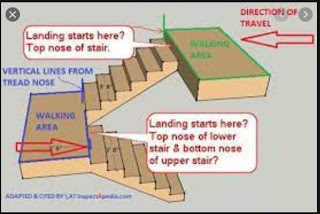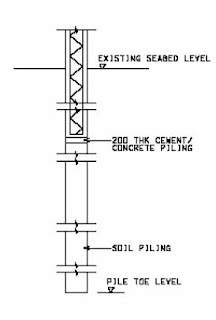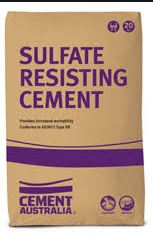1. Why is sulphate-resisting cement not used in marine concrete?
The main components of Portland cement are tricalcium silicate, dicalcium silicate, tricalcium aluminate and tetracalcium aluminoferrite. In sulphate-resisting cement, it contains a low amount of tricalcium aluminate in order to avoid sulphate attack. Otherwise, tricalcium aluminate would react with sulphates to form calcium sulphoaluminate and gypsum that cause expansion and crack the concrete structure.
However, for marine concrete sulphate-resisting cement should not be used because tricalcium aluminate has high affinity for chloride ions. This is based on the possible reaction of chloride ions and tricalcium aluminate to form calcium chloroaluminate hydrate as suggested by P. Kumar Mehta (1991) and the reduction of which may increase the rate of chloride attack to the concrete marine structure and result in faster corrosion of steel reinforcement in marine structures.
2. Shall a layer of wearing course or additional thickness be designed on the surface of piers?
In the design of piers, consideration should be given to the effect of wearing action caused by passengers, other traffics and even sometimes vehicles. In maritime environment, the durability and integrity of concrete is detrimental to the servicing life of piers because it acts an essential barrier to chloride attack. However, in view of these gradual wear and tear generated by the loading traffic, some forms of surface protection should be provided on top of pier surface like wearing course or additional increase in concrete cover.
3.What is the difference in application of surface-protecting fenders and energy-absorbing fenders?
Surface-protecting fenders are fenders that induce high reaction forces to berthing structures for the energy absorbed while energy-absorbing fenders are fenders which transmit low impact to berthing structures for the energy absorbed (Carl A. Thoresen (1988)). In fact, the principal function of fenders is to absorb the berthing energy and transmit a force to the structures without damaging them. Therefore, in open berth structures, it is desirable to use energy-absorbing fenders to reduce the loads acting on the relatively flexible structures. On the other hand, for solid berth structures the usage of surface-protecting fenders is adequate because they are capable of taking up large berthing loads.
4. Should dolphins be designed in a rigid manner, i.e. resting on several raking piles?
In designing dolphins, they are normally supported on a system of three to four raking piles. This in essence is a rigid structure and exhibits little flexibility e.g. movement against impact and berthing loads by vessels. In fact, this kind of design may not be desirable in terms of maintenance because the dolphins are readily susceptible to damage by high berthing vessels. To rectify this situation, some energy absorption devices like rubber/plastic fenders have to be installed to reduce the impact load deriving from its own deflection. On the other hand, by designing dolphins as flexible structures capable for allowing slight deflection, it helps to reduce the large forces generated during berthing of vessels. In this connection, one way of designing dolphins as flexible structures is by provision of a single pile only.
Note: For a rigid structure, it takes up external loads without undergoing excessive deformations.
 |
| Should dolphins be designed in a rigid manner, i.e. resting on several raking piles |
5. In connecting fenders to pier structures, should single lock nuts or double lock nuts be used?
In many pier structures the connection of fenders to piers is achieved by using single lock nuts. However, they do not perform well because some timber fenders loosen more easily when subject to vibrating loads due to berthing, wave and tidal actions. To solve this problem, double lock nuts should be adopted as they prove to function satisfactory in other structural elements which are subject to frequent vibration loads.
Note: Double lock nuts mean two nuts are adopted in a single bolt connection between fenders and marine structures.
6. What is the design level of landings in piers?
Landings are designed as resting place for passengers during berthing and deberthing of vessels. In general, landings are provided near mean high and mean low water levels to facilitate embarking and disembarking of passengers (BS6349: Part 2: 1988). Therefore, the level of landing steps should be different from place to place because of different mean high and mean low water levels in different locations.
 |
| the design level of landings in piers |
7. What are the pros and cons of using timber fenders, plastic fenders and rubber fenders?
Timber fenders:
They are low in strength and are subject to rotting and marine borer attack. Moreover, they have low energy absorption capacity and the berthing reaction depends on the point of contact. The contact pressure between fender and vessels are high. They are considered to be environmentally unfriendly because they consume tropical hardwoods in their production.
Plastic fenders:
Their strength is similar to that of timber fenders but they have relatively high abrasive resistance. They are resistant to chemical and biological attack. Their energy absorption capacities are moderate and the berthing reactions are also dependent on the point of contact. The reaction is lower when compared with timber fenders for a given energy absorption. They are considered to be environmental friendly because they are manufactured from recycled material.
Rubber fenders:
They possess high abrasive resistance and are also resistant to most biological and chemical attacks. They have moderate to high energy absorption capacity and the energy absorption performance is independent of the point of contact. Similar to plastic fenders, they are also environmental friendly products.
8. Why are most marine piles circular in cross section?
For marine piles, there are several options available for selection, namely H-piles, circular pipes and box piles.
However, only circular piles and box piles are suitable for marine application because of the following two reasons suggested by G. M. Cornfield (1968):
(i) Circular piles and box piles possess high column buckling strength. For marine structures like jetties, piles are well above seabed level and therefore the column buckling effect is significant when compared with other structures. Therefore, it is essential to use pile sections which have relatively high buckling strength in piers.
(ii) Circular piles and box piles display high energy absorbing capability. For marine structures like dolphins and fenders, which require substantial amount of berthing energy to be absorbed, these piles sections are inevitably good choices.
In marine structures, it appears that circular sections prevail over the box sections. The main reason is that the range of section available for selection of circular piles is more than that of box piles.
9. For marine pile type of steel tubular piles with reinforced concrete infill, minimum toe level is often specified in contract drawings. What is its purpose?
The purpose of minimum toe level is two-fold:
(i) In detailed design stage, ground investigation should be conducted and the approximate level of rockhead is known. Therefore, to avoid the marine piles to be founded prematurely on boulders, minimum toe levels of marine driven piles are specified in contract.
(ii) It provides sufficient length of soils for lateral and uplift resistance.
Note: Minimum toe level refers to the minimum level that a marine driven pile should be driven into seabed.
10. What is the problem in traditional marine piling system of steel tubular pile with concrete infill and what are the possible remedial measures?
In the design of marine piles of steel tubular piles with concrete infill, loads from pier deck are taken up by steel tubular piles before the occurrence of corrosion of steel piles above seabed. In fact, it is assumed that steel piles above seabed level will all be corroded after a certain year. The load transfer mechanism after complete corrosion of steel pile above seabed is as follows: loads from pier deck are taken up by concrete infill above the seabed level. Below the seabed level, loads would be transferred to steel piles through frictional forces between concrete infill and steel casings.
However, substantial radial shrinkage and contraction occurs after concreting of concrete infill and this will hinder the load transfer from the concrete infill to steel piles because the bond may be ruptured by radial shrinkage. It is in doubt if frictional forces can be properly developed in this situation. To solve this problem, shear keys could be installed at regular spacing inside steel piles to ensure their rigid connection with concrete infill. Alternatively, expanding agents may be adopted in concrete mixes to ensure that there is no shrinkage after the concreting process.
11. Why are steel tubular marine piles often driven open-ended?
In marine structures where piles are constantly subject to significant lateral and uplift forces induced by berthing operation and wave action, it is necessary to drive the piles to much greater depth. To avoid premature refusal so that insufficient soil cover may develop which is incapable of providing the required lateral and uplift resistance, tubular piles are normally driven open-ended so that they are driving to greater depths than piles with closed ends
 |
| Typical details of marine piles. |
 |
| Force polygon of pile bent. |







No comments:
Post a Comment
If you are getting more information from civilengineerfriend page please give your comments. Share the page information in your whatsapp group. Subscribe our page to get more information.